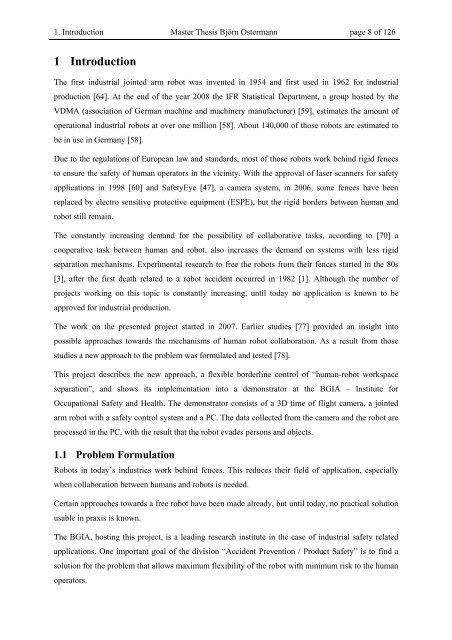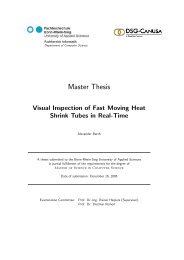Master Thesis - Hochschule Bonn-Rhein-Sieg
Master Thesis - Hochschule Bonn-Rhein-Sieg
Master Thesis - Hochschule Bonn-Rhein-Sieg
Create successful ePaper yourself
Turn your PDF publications into a flip-book with our unique Google optimized e-Paper software.
1. Introduction <strong>Master</strong> <strong>Thesis</strong> Björn Ostermann page 8 of 126<br />
1 Introduction<br />
The first industrial jointed arm robot was invented in 1954 and first used in 1962 for industrial<br />
production [64]. At the end of the year 2008 the IFR Statistical Department, a group hosted by the<br />
VDMA (association of German machine and machinery manufacturer) [59], estimates the amount of<br />
operational industrial robots at over one million [58]. About 140,000 of those robots are estimated to<br />
be in use in Germany [58].<br />
Due to the regulations of European law and standards, most of those robots work behind rigid fences<br />
to ensure the safety of human operators in the vicinity. With the approval of laser scanners for safety<br />
applications in 1998 [60] and SafetyEye [47], a camera system, in 2006, some fences have been<br />
replaced by electro sensitive protective equipment (ESPE), but the rigid borders between human and<br />
robot still remain.<br />
The constantly increasing demand for the possibility of collaborative tasks, according to [70] a<br />
cooperative task between human and robot, also increases the demand on systems with less rigid<br />
separation mechanisms. Experimental research to free the robots from their fences started in the 80s<br />
[3], after the first death related to a robot accident occurred in 1982 [1]. Although the number of<br />
projects working on this topic is constantly increasing, until today no application is known to be<br />
approved for industrial production.<br />
The work on the presented project started in 2007. Earlier studies [77] provided an insight into<br />
possible approaches towards the mechanisms of human robot collaboration. As a result from those<br />
studies a new approach to the problem was formulated and tested [78].<br />
This project describes the new approach, a flexible borderline control of “human-robot workspace<br />
separation”, and shows its implementation into a demonstrator at the BGIA – Institute for<br />
Occupational Safety and Health. The demonstrator consists of a 3D time of flight camera, a jointed<br />
arm robot with a safety control system and a PC. The data collected from the camera and the robot are<br />
processed in the PC, with the result that the robot evades persons and objects.<br />
1.1 Problem Formulation<br />
Robots in today’s industries work behind fences. This reduces their field of application, especially<br />
when collaboration between humans and robots is needed.<br />
Certain approaches towards a free robot have been made already, but until today, no practical solution<br />
usable in praxis is known.<br />
The BGIA, hosting this project, is a leading research institute in the case of industrial safety related<br />
applications. One important goal of the division “Accident Prevention / Product Safety” is to find a<br />
solution for the problem that allows maximum flexibility of the robot with minimum risk to the human<br />
operators.














